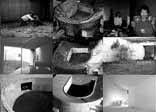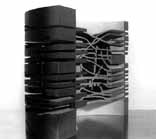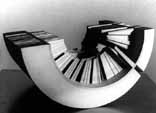|
|
||||
| The Virtual House
Competition Luigi Centola |
||||
| [in italiano] | What is a
virtual house? It is not the technological villa Bill Gates has recently built, a house which is completely wired to serve and protect the body. It might be, instead, the house that the philosophers and architects invited to the Berlin forum characterized as constructed around "new spaces of body and mind". Not a house conceived to satisfy the body but the mind. |
[28jul2000] | ||
 Peter Eisenman. |
John Rajchman, professor of the Collège International de Philosophie,
points out some of its main features: "The Virtual House through its plan, space,
construction and intelligence, generates the most new connections; it is arranged or
disposed to permit the greatest power for unforeseen relations. It most catches us by
surprise in our very manners of thinking and being. (...) it is the one whose arrangement
or disposition allows for the greatest number of singular points and the most complex
connections among them. If the Virtual House is not completely specified by fixed
qualities, it is because it is a dynamic space prior to any qualifications, so smooth that
fixed qualities do not stick to it, are always slipping off it. Its geometry is not drawn
from fixed points.The virtual looks like nothing that we already know or see".
Rajchman underlines the fundamental step that one must take from an understanding of
Virtual House to that of Virtual Space, a space with a new and unsettled character which
guarantees "freedom of the body and movement. The virtual construction - he says -
departs from the kinds of organizations that try to set out all possibilities in advance.
It constructs a space whose rules can themselves be altered through what happens in
it". This theory sounds complete, but the house has yet to be designed… Let's see how Nouvel, Ito, Eisenman and Libeskind played this game. In the movie the Fifth Element director Luc Besson recreated a scene from Blade Runner. We imagine Bruce Willis in a Chinatown until the next scene reveals that he has been standing next to something that resembles the space shuttle. In the same way Jean Nouvel's house is a sophisticated technological thing, transformed from a classical model: Palladio's villa Malcontenta. He rediscovers it in a jewel of technology. In his idea of the virtual - textures, multiple transparencies and reflections transform the simple and symmetrical palladian composition into something completely new. The proposed computer animation allows one to glide from the exterior to the interior and appreciate these transformations of space. Nouvel's commitment to build almost without materials or at least with a minimal use of them, always on the edge between classical and modernity, clearly emerges in this project and in his recent work. |
The Virtual House Competition The Virtual House Competition Projects by: Jean Nouvel, Toyo Ito, Peter Eisenman, Daniel Libeskind, Jacques Herzog & Pierre de Meuron, Alejandro Zaera-Polo Jury: Kurt Forster, Akira Asada, Rebecca Horn Philosophers: Gilles Deleuze, John Rajchman, Eric Alliez, Erik Oger, Elizabeth Grosz, Paul Virilio, Gilles Châtelet Organization: ANY New York, 1997 Conditions for the Virtual House: - the site for The Virtual House is flat - the size of the Virtual House is to be a maximum of 200 square meters - the Virtual House should be enclosing, sheltering, grounding and buildable - the Virtual House may accomodate between one and four persons -possibly two adults and two children- and a domestic animal - the Virtual House will answer to the description by John Rajchman - the architects will present their Virtual Houses in a public forum in Berlin |
||
The Oscar for the "virtual house" original screen-play if you
will, goes to Toyo Ito. The life of his U White house spans twenty years. Ito refuses to
design the virtual house, he believes it is only possible to design the virtual house when
we have resolved the boundaries between incompatible spatial experiences. In contrast he
chooses the short life of a home built for several dear ones, in which the interior space
without windows expresses the inconstancy of their lives: at times lonely or segregated.
The home is the place of the family, and now that the house is destroyed and their lives
fragmented, another house exists that is impossible to design, a virtual space that curves
to embrace the family. Peter Eisenman. To fully understand Peter Eisenman's and Daniel Libeskind's schemes it is useful to consider a comparison between two completely different cars: a concept car exhibited at an international show, rotating under the spotlights, perhaps even without its engine; and a Formula 1 with its engine tested on the track. In the first, the design of its body and details is pushed to the limit, and in a few years or even months will become the standard; in the second the engine will become the standard of production. Both are fundamental steps for the development of a new car but in fact they are different manifestations of that process. |
  Jean Nouvel. |
|||
  Toyo Ito. |
Eisenman, following his recent works, continues to radically experiment in
the formed and the un-formed, or that which is generated from crystalline geometries. The
starting point is a computer generated animation (Silycon Graphics) in which the
trajectories, frozen in time, generate the volumetric idea. On top of this idea is
superimposed the design of the house. It no longer matters what happens first, the idea of
a space or the techniques to build it, they are completely indistinguishable. The virtual,
following Eisenman, is built on the endless potential of the interaction between form and
space. It is the arbitrary choice that generates instantaneous configurations and they are
always unique. The accompanying text speaks to the method that Eisenman has applied for
many years in opposition to formal classical constraints such as function and meaning. Libeskind instead designed the universal engine: 365 ring segments or days of the year, rotating around an empty center and an axis that he says "could be called Architecture". This project expresses brilliantly the fundamental aspects of a virtual space, it is the only one without definite scale, it can be read and understood from a microscopic to a macroscopic perspective and perhaps beyond. Not by chance the title of the accompanying text is "Virtual Infinity". Libeskind begins with the Chamberworks series of drawings, making use for the first time of curves; but here developing strategies already tested in both his main projects: the Jewish Museum in Berlin and the Victoria & Albert extention in London. As in the virtual house it is always a concept abstractly symbolic and spatial that generates the buildings: the empty and broken rectilinear memory of the Holocaust in Berlin, the shifting axis of knowledge around which spirals the continuous wall of the new building in London. |
  Peter Eisenman. |
||
  Jean Nouvel. |
Even though these four schemes are vastly different from one another, all
of them demonstrate a fascination with the virtual, mainly in the sense of space-time
relationships: movement frozen in a casual instant, ever changing characters of space and
form. While at the same time the individual work of each architect emerges in their
projects for the virtual house. Through it would not have been difficult to recognize the
identities of each of these architects in the projects, there is always unforeseen
experimentation typical of visionaries. In regard to formal aspects, following the two
extreme categories proposed by Jeffrey Kipnis in his essay "Towards a New
Architecture", Nouvel and Libeskind are inside In-Formation, Eisenman in
De-Formation. It is not surprising that Nouvel (together with Foster, Koolhaas, Tschumi,
Herzog & de Meuron, only to quote the best known) occupies the first, and Eisenman
(with Gehry, Miralles, Hadid, Coop Himmelblau) the second - but Libeskind falling into the
category of In-Formation is a big surprise. He believes that the "Concept" is so
important that it forces him for the first time to engage the pure form, that of the
cylinder. It is indeed the concept: be it spatial, formal, symbolic, abstract, religious
or virtual, that always generates a coherent design. But which one is the "real" virtual house? The ideal scheme would have been that with Libeskind's pure concept, Eisenman's extreme skills and experimentation in the drawing, Ito's sentiment, Nouvel's simplicity and modernity in construction. And with such a construct there are as well many other possibilities, because..."the virtual looks like nothing that we already know or see". Luigi Centola lctuff@tin.it |
   Daniel Libeskind. |
||
Extended Play IN A BIT |
||||
laboratorio
|
||||